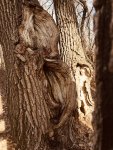Been living here 30 yrs and only a few years ago the wife was trudging through the thick part of the woods and found this giant cottonwood tree that had suffered a calamity of some sort during its youth, apparently. I thought lightning at first, but there's no hint of charring whatsoever. Maybe the fire scarring had long healed over? At any rate it was never able to close the wound and struggled for survival. Guessing it's a good 90 ft in height at least and a good 40" diameter at the base. The injury spans a good 6 ft or more in total height.
Since it's in the original row of cottonwood trees transplanted by the homesteaders it dates back to the late 1890's or very early 1900's. If only it could talk. Expand the pics for a closer look. Any ideas?



Another giant cottonwood nearby had the same growth/injury? but had fallen over with the injury facing down. It fell apart with rot when I tried to cut it free and roll the injured portion over. A professional photographer heard about the trees and took a great black and white photo of it for his portfolio and gave us a nice copy recently.
Since it's in the original row of cottonwood trees transplanted by the homesteaders it dates back to the late 1890's or very early 1900's. If only it could talk. Expand the pics for a closer look. Any ideas?



Another giant cottonwood nearby had the same growth/injury? but had fallen over with the injury facing down. It fell apart with rot when I tried to cut it free and roll the injured portion over. A professional photographer heard about the trees and took a great black and white photo of it for his portfolio and gave us a nice copy recently.

